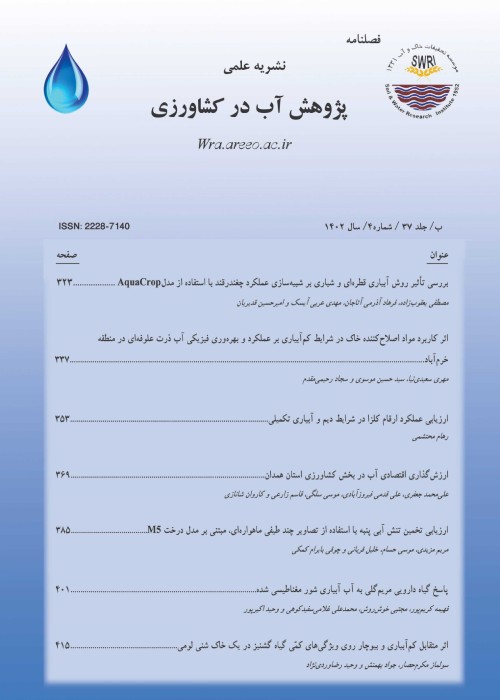Effect of Salinity and Amount of Irrigation Water on Forage Sorghum Yield in Sistan Plain
Author(s):
Abstract:
The main factor for managing and scheduling irrigation in dry area, is the plant response to drought stress. The majority of irrigation water in these areas contains soluble salts, therefore, salinity stress should be considered at the same time. Hence, this study was conducted in order to obtain the optimum depth of irrigation, considering drought and salinity stress individually and simultaneously, at three cutting times of forage sorghum in Sistan plain.This experiment used split plot in time in a factorial design with three levels of salinity (2, 5, and 8 dS.m-1) and four irrigation levels (50%, 75%, 100%, and 120% water requirement) at three cutting stages, with three replications. The depth of the water was determined for salinity levels and at various cuttings. In order to determine the separate and combined effects of salinity and irrigation water, the following criteria were used were used in each cutting: the index of final production compared to irrigation water depth (MPI), the final production compared to the salinity (MPECw), marginal rate of technical replacement for salinity and water (MRTSI, ECw ), the final output value of the irrigation water depth (VMPI), and the final output value of the salinity (VMPECw). MPI index showed that for each one centimeter increase in irrigation water depth, the first cutting had the least change in production(1.22 ton.ha-1) and the third cutting had the maximum amount (9.2 ton.ha-1). MPECw index showed that in the low salinity treatments, the second and third cuttings had, respectively, the lowest and the highest yield loss. MRTS index showed that in order for production to stay the same with one unit increase in salinity, the irrigation water depth must increase in the first, second, and third cuttings by, respectively, 5.86, 1.97 and 1.72 centimeter. Also, with increasing salinity levels in the all three cutting, optimum irrigation depth increased and in the all salinity levels, optimum irrigation depth in the first cutting was more than the second cutting, and in the second cutting it was more than the third cutting.
Keywords:
Language:
Persian
Published:
Journal of Water Research in Agriculture, Volume:31 Issue: 1, 2017
Pages:
13 to 28
magiran.com/p1702840
دانلود و مطالعه متن این مقاله با یکی از روشهای زیر امکان پذیر است:
اشتراک شخصی
با عضویت و پرداخت آنلاین حق اشتراک یکساله به مبلغ 1,390,000ريال میتوانید 70 عنوان مطلب دانلود کنید!
اشتراک سازمانی
به کتابخانه دانشگاه یا محل کار خود پیشنهاد کنید تا اشتراک سازمانی این پایگاه را برای دسترسی نامحدود همه کاربران به متن مطالب تهیه نمایند!
توجه!
- حق عضویت دریافتی صرف حمایت از نشریات عضو و نگهداری، تکمیل و توسعه مگیران میشود.
- پرداخت حق اشتراک و دانلود مقالات اجازه بازنشر آن در سایر رسانههای چاپی و دیجیتال را به کاربر نمیدهد.
In order to view content subscription is required
Personal subscription
Subscribe magiran.com for 70 € euros via PayPal and download 70 articles during a year.
Organization subscription
Please contact us to subscribe your university or library for unlimited access!


